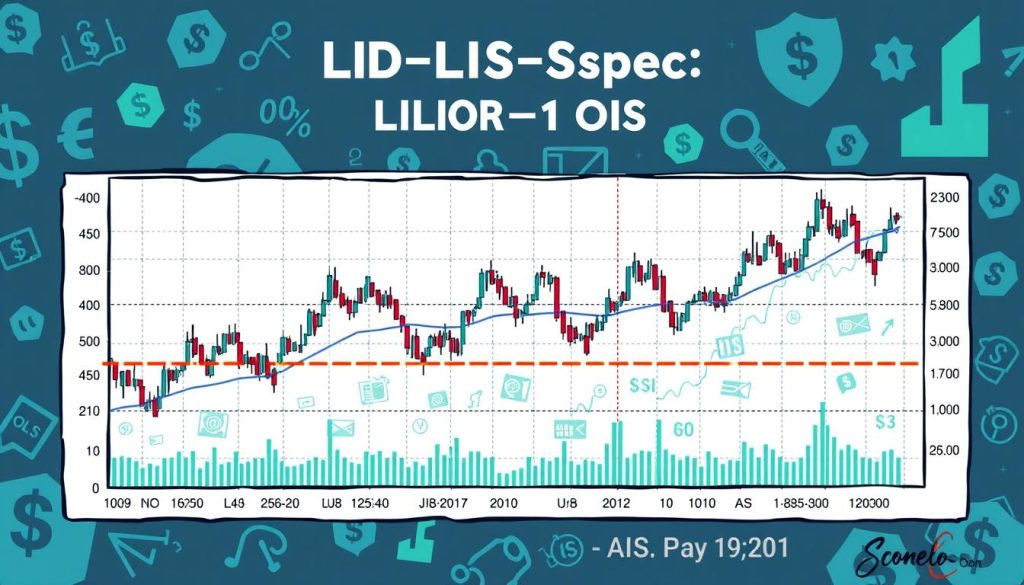The financial world is changing fast, making the LIBOR-OIS spread very important for experts. This spread shows the difference between the London Interbank Offered Rate (LIBOR) and the overnight indexed swap (OIS) rate. It tells us about the health of money markets and the risk banks face1. With LIBOR ending by 2021, knowing about the LIBOR-OIS spread is key for moving to new risk-free rates.
This guide will explain the LIBOR-OIS spread in detail. We’ll look at what makes it tick, what affects it, and why it matters to financial pros. Learning about the LIBOR-OIS spread helps you understand lending between banks, credit risk, and new chances in the changing interest rate world.
Key Takeaways
- The LIBOR-OIS spread is a key sign of risk in financial markets.
- It’s vital to know about the LIBOR-OIS spread since LIBOR will soon be phased out.
- Things like interest rate differences, credit risk, liquidity, and market feelings affect the LIBOR-OIS spread.
- The spread sheds light on bank funding costs and chances in interest rate derivatives.
- Financial experts must work with others and prepare for the shift to new risk-free rates.
Understanding the LIBOR-OIS Spread
The LIBOR-OIS spread is key in finance, showing how stable the interbank lending market is. It’s the difference between the London Interbank Offered Rate (LIBOR) and the overnight indexed swap (OIS) rate2. LIBOR is the rate banks lend to each other. The OIS rate is tied to the central bank’s benchmark rate3.
What is the LIBOR-OIS Spread?
This spread shows the credit risk and liquidity premium in lending between banks2. Before the 2007-2008 crisis, it was very small2. But during the crisis, it grew to 3.65 percentage points2. This meant more risk and stress in the financial world.
Components of the LIBOR-OIS Spread
The spread has two parts: the credit risk premium and the liquidity premium. The credit risk premium shows how trustworthy banks are in lending to each other3. The liquidity premium shows how easy it is for banks to get funding3. When banks face more credit and liquidity issues, the spread gets wider, showing more financial stress.
The Intercontinental Exchange will stop publishing some USD LIBOR rates by Dec. 31, 2021, and all by June 30, 20232. This change will greatly affect the financial industry and how we look at the LIBOR-OIS spread.
| Metric | Description |
|---|---|
| LIBOR | The London Interbank Offered Rate, which represents the average interest rate at which banks lend to one another in the interbank market3. |
| OIS | The Overnight Indexed Swap rate, which represents a country’s central bank rate over a specified period, like the Fed funds rate in the US3. |
| LIBOR-OIS Spread | The difference between the LIBOR and OIS rates, which reflects the perceived credit risk and liquidity premium in the interbank lending market2. |
The LIBOR-OIS spread shows the credit risk in banking, telling us about the financial sector’s health2. A wider spread means more risk in lending, while a narrower spread means better conditions and less risk234.
Factors Influencing the LIBOR-OIS Spread
The LIBOR-OIS spread shows how the interbank lending market works together. It’s mainly affected by two things: credit risk and liquidity premium5.
Credit Risk and Liquidity Premium
Credit risk premium shows how banks see each other’s trustworthiness. This is because LIBOR is based on their lending rates. When credit risk goes up, the LIBOR-OIS spread gets wider. Banks then want a higher return for lending to each other6.
Liquidity premium looks at how easy it is for banks to get funding. If getting funding gets harder, the LIBOR-OIS spread goes up. Banks then want more money for lending in the interbank market6.
Interest Rate Differentials and Market Conditions
Interest rate differences and market conditions also affect the LIBOR-OIS spread. These differences show what the market thinks interest rates will do in the future and what the central bank might do5.
Changes in economic indicators like GDP growth, inflation, and unemployment matter too. They can change how banks see credit risk and liquidity in the interbank market5.

Knowing what affects the LIBOR-OIS spread helps financial experts understand the interbank lending market and the financial world better7.
Analyzing the LIBOR-OIS Spread
The LIBOR-OIS spread is key for financial experts to watch. It shows the health of the financial system and where to find good investments. By looking at the spread, you can understand credit and liquidity risks in the lending market. This helps with managing interest rate risk, planning fixed income strategies, and spotting arbitrage chances8.
Before trouble hit, deposit-OIS spreads were usually low, under ten basis points for up to a year and less for shorter times8. But in summer 2007, these spreads jumped, showing big worries about credit and liquidity8. The one-month spread went down thanks to central bank actions, but the 12-month spread stayed high. This shows shorter times show more liquidity risk, while longer times show more credit risk8.
To understand the LIBOR-OIS spread, use the formula L – R, where L is LIBOR and R is OIS9. This spread is like a borrower’s credit risk plus a lender’s liquidity risk, based on time to maturity9. Studies have shown the spread follows a square root pattern, matching this theory9.
The Libor curve shows different times from overnight to 12 months, giving clues about the market10. Short times show now, while long times show what’s expected later10. Things like central bank actions, economic data, and market feelings affect the curve, helping you plan investments10.

Watching the LIBOR-OIS spread helps you understand market feelings and risk views. This can guide your fixed income strategies and arbitrage opportunities10. As the financial world moves away from LIBOR, this analysis aids in adjusting to new rates like SOFR and SONIA, and handling interest rate risk well8.
LIBOR-OIS Spread: Implications for Financial Professionals
The LIBOR-OIS spread shows how much banks pay to borrow money and their risk levels. Since LIBOR is a key rate for bank loans, the spread tells us about the bank’s credit and liquidity risks10. Financial experts use this info to understand bank funding costs and risks. This helps them make better investment choices and manage risks.
Insights into Bank Funding Costs
The LIBOR-OIS spread points to the risks and liquidity in bank lending10. In 2008, the spread grew big because of credit and liquidity worries10. Watching the spread helps us see how banks are doing, their liquidity, and the overall financial health10. Knowing about the Libor curve and the spread is key for smart investment, hedging, and risk management10.
Opportunities in Interest Rate Derivatives
The LIBOR-OIS spread also opens doors for financial pros in interest rate derivatives. As LIBOR changes, the spread can spot arbitrage chances and help with hedging10. By grasping the spread’s dynamics, experts can adapt to the changing interest rate derivatives market.
| Key Insights | Implication for Financial Professionals |
|---|---|
| The LIBOR-OIS spread shows the risks and liquidity in bank lending10. | Helps understand bank funding costs and liquidity risks to guide investment and risk management. |
| The 2008 crisis made the LIBOR-OIS spread wider due to credit and liquidity issues10. | Watching the spread reveals bank creditworthiness, liquidity, and financial stability10. |
| The spread helps find arbitrage chances and hedging strategies as LIBOR changes10. | Use the spread to navigate the interest rate derivatives market’s changes. |
Understanding the LIBOR-OIS spread gives financial pros deep insights into bank funding, liquidity, credit, and interest rate risks. This info helps with investment decisions, risk management, and creating new interest rate derivatives. As finance changes, knowing the LIBOR-OIS spread can give a competitive edge.
Conclusion
The11 LIBOR-OIS spread is key for financial experts to watch. It shows important info on credit risk, liquidity, and the financial system’s health. As we move from LIBOR to new risk-free rates, knowing about the LIBOR-OIS spread is vital. It helps you manage11 interest rate risk and make smart investment plans.
During the 2007-2009 financial crisis, the 3-month LIBOR was about 100 basis points above OIS rates11. By 2019:Q3, only less than 3 percent of Global Systemically Important Banks’ liabilities were short-term wholesale unsecured funding. This shows how crucial it is to keep an eye on the LIBOR-OIS spread. It tells us about credit risk and liquidity in the financial world.
With the shift to alternative risk-free rates, knowing about the LIBOR-OIS spread is more important than ever. It helps you navigate the changing world of12 $150 trillion financial products tied to Libor. By understanding the LIBOR-OIS spread and its causes, you can predict and adjust to changes in interest rates and liquidity. This puts your company in a strong position for the future.
FAQ
What is the LIBOR-OIS spread?
The LIBOR-OIS spread is the difference between the London Interbank Offered Rate (LIBOR) and the overnight indexed swap (OIS) rate. It shows the credit risk and liquidity premium in the interbank lending market.
What are the main components of the LIBOR-OIS spread?
The LIBOR-OIS spread has two main parts: the credit risk premium and the liquidity premium. The credit risk premium shows how trustworthy banks are in the lending market. The liquidity premium shows how easy it is for banks to get funding.
What factors influence the LIBOR-OIS spread?
The LIBOR-OIS spread is mainly affected by credit risk and liquidity premium. It also changes with interest rate differences and broader market conditions. These include GDP growth, inflation, and unemployment.
How can financial professionals use the LIBOR-OIS spread?
By looking at the LIBOR-OIS spread, financial experts can understand the financial system’s health and find investment chances. It helps with managing interest rate risks, setting fixed income strategies, and spotting arbitrage opportunities.
What are the implications of the LIBOR-OIS spread for financial professionals?
The LIBOR-OIS spread gives clues about bank funding costs and liquidity risks. This information helps with investment decisions and risk management. It also opens up chances for financial experts in the interest rate derivatives market as LIBOR is replaced by alternative rates.
Source Links
- Swap Spread Analysis: A Guide for Investors – FasterCapital
- What Is the LIBOR-OIS Spread and Why Does It Matter?
- What the Libor-OIS Spread Says
- Overnight indexed swap
- What drives interbank rates? Evidence from the Libor panel – BIS Quarterly Review, part 4, March 2008 – International banking and financial market developments
- What drives the Libor–OIS spread? Evidence from five major c
- EVIDENCE ON LIQUIDITY AND CREDIT RISK FROM DEPOSIT-OIS SPREADS
- Libor Curve and LIBOR OIS Spread: Examining Market Sentiment – FasterCapital
- How Correlated is LIBOR with Bank Funding Costs?
- Behavior of Libor in the Current Financial Crisis – San Francisco Fed

